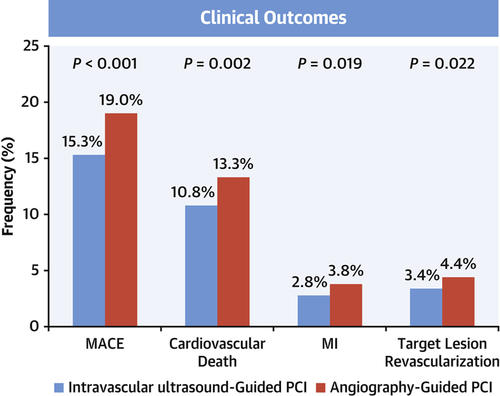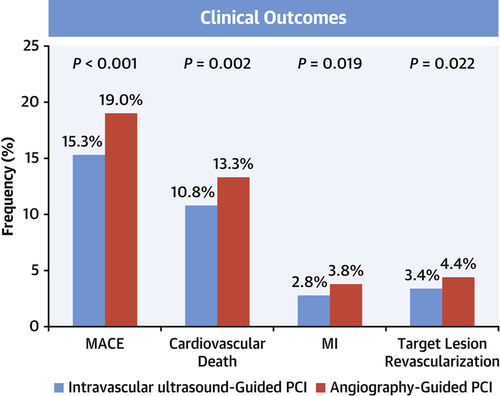04 Nov 2021
Impact of intravascular ultrasound on long-term clinical outcomes in patients with acute myocardial infarction
Selected in JACC Cardiovascular Interventions by F. Spione , S. Brugaletta
There are limited data evaluating long-term outcomes of IVUS use in patients with acute myocardial infarction (AMI). The aim of this study was to examine the impact of IVUS-guided PCI on long-term clinical outcomes in patients with AMI.
References
Authors
Ik Jun Choi, Sungmin Lim, Eun Ho Choo, Byung-Hee Hwang, Chan Joon Kim, Mahn-Won Park, Jong-Min Lee, Chul Soo Park, Hee Yeol Kim, Ki-Dong Yoo, Doo Soo Jeon, Ho Joong Youn, Wook-Sung Chung, Min Chul Kim, Myung Ho Jeong, Youngkeun Ahn, and Kiyuk Chang
Reference
10.1016/j.jcin.2021.08.021
Published
October, 26 2021
Link
Read the abstractReviewers
Our Comment
Why this study? – the rationale/objective
There are limited data evaluating long-term outcomes of IVUS use in patients with acute myocardial infarction (AMI). The aim of this study was to examine the impact of IVUS-guided PCI on long-term clinical outcomes in patients with AMI.
How was it executed? - the methodology
By using the COREA-AMI (Cardiovascular Risk and Identification of Potential High-Risk Population in Acute Myocardial Infarction) I and II registries, all patients with AMI from January 2004 to August 2014 were included (n = 10,719 patients). Clinical follow-up was performed as far as possible till 2019.
The included patients were classified in 2 groups according to use of IVUS. The primary endpoint of MACE was a composite of cardiovascular death, myocardial infarction (MI) and target lesion revascularization (TLR).
What is the main result?
A total of 9,846 patients were included in the final analysis: 2,032 treated with IVUS-guided PCI and 7814 with angiography-guided PCI. IVUS-guided PCI was associated with reduced MACE (HR: 0.779; 95% CI: 0.689-0.880; p < 0.001).
The individual components of cardiovascular death (HR: 0.793; 95% CI: 0.686-0.913; p = 0.002), MI (HR: 0.709; 95% CI: 0.533-0.944; p = 0.019) and TLR HR: 0.737; 95% CI: 0.568-0.956; p = 0.022) were significantly lower in the IVUS-guided PCI group. The results were consistent after multivariable regression and propensity score matching. One-year landmark analysis showed a lower risk for MACE within 1 year (HR: 0.766; 95% CI: 0650-0.903; p = 0.002) and beyond 1 year (HR: 0.796; 95% CI: 0663-0.956; p = 0.014) after index PCI.

Source: JACC Cardiovascular Interventions
Critical reading and the relevance for clinical practice
The present study analyses a very common situation in our daily work routine, which is PCI in the setting of AMI. Numerous studies and meta-analysis have established how IVUS use is associated with better long-term outcomes, up to 10 years of follow-up, when compared to angiography-guided PCI alone. The additional value of this study is the effectiveness of IVUS in an acute coronary setting with improved short and long-term outcomes. It is particularly interesting to see that IVUS use may affect outcome up to 4 year, suggesting that a mechanical acute stent optimization may last long.
The study unfortunately does to not provide any data about which kind of IVUS data were used in terms of either PCI planning or PCI optimization, which may be of particular importance in a thrombotic clinical setting such as acute coronary syndromes. Nevertheless, we have indirect data about the effectiveness of such PCI optimization, considering that IVUS group received stent bigger and longer.
Eventually, it should be considered that in these patients, considering the need to act fast in an acute context during night or weekends, especially in STEMI (which represents 50% of patients included) IVUS is not usually performed. Use of IVUS would also increase the cost of the procedure, which may be probably counterbalanced by a reduction in the long-term costs. Do you use IVUS routinely in acute myocardial infarction?






1 comment
I use IVUS in acute setting on a case to case basis, mainly guided by clinical condition of the patient and the type of lesion i am facing